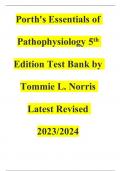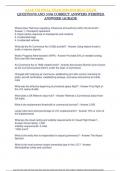Porth's Essentials of
Pathophysiology 5 th
a l
Edition Test Bank by
it
e n
if d
Tommie L. Norris
o n
Latest Revised
C
2023/2024
, TEST BANK FOR PORTH'S PATHOPHYSIOLOGY 10TH EDITION BY NORRIS
Porth’s Pathophysiology 10th Edition Norris Test Bank
1. At an international nursing conference, many discussions and breakout sessions focused
on the World Health Organization (WHO) views on health. Of the following comments
made by nurses during a discussion session, which statements would be considered a
good representation of the WHO definition? Select all that apply.
A) Interests in keeping the elderly population engaged in such activities as book
reviews and word games during social time
B) Increase in the number of chair aerobics classes provided in the skilled care
facilities
l
C) Interventions geared toward keeping the elderly population diagnosed with
it a
diabetes mellitus under tight blood glucose control by providing in-home cooking
classes
D) Providing transportation for renal dialysis patients to and from their hemodialysis
sessions
E) Providing handwashing teaching sessions to a group of young children
n
Ans: A, B, C, E
Feedback:
e
The WHO definition of health is defined as “a state of complete physical, mental, and
social well-being and not merely the absence of disease and infirmity.” Engaging in
d
book reviews facilitates mental and social well-being; chair aerobics helps facilitate
physical well-being; and assisting with tight control of diabetes helps with facilitating
fi
physical well-being even though the person has a chronic disease. Handwashing is vital
in the prevention of disease and spread of germs.
n
2. A community health nurse is teaching a group of recent graduates about the large
variety of factors that influence an individual's health or lack thereof. The nurse is
o
referring to the Healthy People 2020 report from the U.S. Department of Health and
Human Services as a teaching example. Of the following aspects discussed, which
C
would be considered a determinant of health that is outside the focus of this report?
A) The client has a diverse background by being of Asian and Native American
descent and practices various alternative therapies to minimize effects of stress.
B) The client has a family history of cardiovascular disease related to
hypercholesterolemia and remains noncompliant with the treatment regime.
C) The client has a good career with exceptional preventative health care benefits.
D) The client lives in an affluent, clean, suburban community with access to many
health care facilities.
Ans: B
Feedback:
In Healthy People 2020, the focus is to promote good health to all (such as using
alternative therapies to minimize effects of stress); achieving health equity and
promoting health for all (which includes having good health care benefits); and
promoting good health (which includes living in a clean community with good access to
health care). A client's noncompliance with treatments to control high cholesterol levels
within the presence of a family history of CV disease does not meet the “attaining lives
free of preventable disease and premature death” determinant.
, TEST BANK FOR PORTH'S PATHOPHYSIOLOGY 10TH EDITION BY NORRIS
3. A physician is providing care for a number of patients on a medical unit of a large,
university hospital. The physician is discussing with a colleague the differentiation
between diseases that are caused by abnormal molecules and diseases that cause disease.
Which of the following patients most clearly demonstrates the consequences of
molecules that cause disease?
A) A 31-year-old woman with sickle cell anemia who is receiving a transfusion of
packed red blood cells
B) A 91-year-old woman who has experienced an ischemic stroke resulting from
familial hypercholesterolemia
C) A 19-year-old man with exacerbation of his cystic fibrosis requiring oxygen
therapy and chest physiotherapy
l
D) A 30-year-old homeless man who has Pneumocystis carinii pneumonia (PCP) and
it a
is HIV positive.
Ans: D
Feedback:
PCP is an example of the effect of a molecule that directly contributes to disease. Sickle
n
cell anemia, familial hypercholesterolemia, and cystic fibrosis are all examples of the
effects of abnormal molecules.
e d
4. A new myocardial infarction patient requiring angioplasty and stent placement has
arrived to his first cardiac rehabilitation appointment. In this first session, a review of
the pathogenesis of coronary artery disease is addressed. Which statement by the patient
fi
verifies to the nurse that he has understood the nurse's teachings about coronary artery
disease?
n
A) “All I have to do is stop smoking, and then I won't have any more heart attacks.”
B) “My artery was clogged by fat, so I will need to stop eating fatty foods like
French fries every day.”
o
C) “Sounds like this began because of inflammation inside my artery that made it
C
easy to form fatty streaks, which lead to my clogged artery.”
D) “If I do not exercise regularly to get my heart rate up, blood pools in the veins
causing a clot that stops blood flow to the muscle, and I will have a heart attack.”
Ans: C
Feedback:
The true etiology/cause of coronary artery disease (CAD) is unknown; however, the
pathogenesis of the disorder relates to the progression of the inflammatory process from
a fatty streak to the occlusive vessel lesion seen in people with coronary artery disease.
Risk factors for CAD revolve around cigarette smoking, diet high in fat, and lack of
exercise.
5. A member of the health care team is researching the etiology and pathogenesis of a
number of clients who are under his care in a hospital context. Which of the following
aspects of clients' situations bN
esUt R
chSaI
raN
ctGerTizBe.
sC
paOthMogenesis rather than etiology?
A) A client who has been exposed to the Mycobacterium tuberculosis bacterium
B) A client who has increasing serum ammonia levels due to liver cirrhosis
C) A client who was admitted with the effects of methyl alcohol poisoning
D) A client with multiple skeletal injuries secondary to a motor vehicle accident
Ans: B
, TEST BANK FOR PORTH'S PATHOPHYSIOLOGY 10TH EDITION BY NORRIS
Feedback:
Pathogenesis refers to the progressive and evolutionary course of disease, such as the
increasing ammonia levels that accompany liver disease. Bacteria, poisons, and
traumatic injuries are examples of etiologic factors.
6. A 77-year-old man is a hospital inpatient admitted for exacerbation of his chronic
obstructive pulmonary disease (COPD), and a respiratory therapist (RT) is assessing the
NU
client for the first time. Which ofRthSeIfN
olG
loTwBin.gCaO
spMects of the patient's current state of
health would be best characterized as a symptom rather than a sign?
A) The patient's oxygen saturation is 83% by pulse oxymetry.
B) The patient notes that he has increased work of breathing when lying supine.
C) The RT hears diminished breath sounds to the patient's lower lung fields
l
bilaterally.
it a
D) The patient's respiratory rate is 31 breaths/minute.
Ans: B
Feedback:
Symptoms are subjective complaints by the person experiencing the health problem,
n
such as complaints of breathing difficulty. Oxygen levels, listening to breath sounds,
and respiratory rate are all objective, observable signs of disease.
e
7. Which of the following situations would be classified as a complication of a disease or
outcome from the treatment regimen? Select all that apply.
d
A) Massive pulmonary emboli following diagnosis of new-onset atrial fibrillation
B) Burning, intense incision pain following surgery to remove a portion of colon due
fi
to intestinal aganglionosis
C) Development of pulmonary fibrosis following treatment with bleomycin, an
n
antibiotic chemotherapy agent used in treatment of lymphoma
D) Gradual deterioration in ability to walk unassisted for a patient diagnosed with
Parkinson disease
o
E) Loss of short-term memory in a patient diagnosed with Alzheimer disease
Ans: A, C
Feedback:
C
Development of pulmonary emboli and pulmonary fibrosis following chemotherapy are
both examples of a complication (adverse extensions of a disease or outcome from
treatment). It is normal to expect incisional pain following surgery. As Parkinson
disease progresses, the inability to walk independently is expected. This is a normal
progression for people diagnosed with Parkinson's. Loss of short-term memory in a
patient diagnosed with Alzheimer disease is an expected finding.
8. Laboratory testing is ordered for a male patient during a clinic visit for a routine
follow-up assessment of hypertension. When interpreting lab values, the nurse knows
that
A) a normal value represenNtsUtR heStI
esNt G
reTsuBl.
tsCthOaM
t fall within the bell curve.
B) if the lab result is above the 50% distribution, the result is considered elevated.
C) all lab values are adjusted for gender and weight.
D) if the result of a very sensitive test is negative, that does not mean the person is
disease free.
Ans: A
Feedback:
What is termed a normal value for a laboratory test is established statistically from





